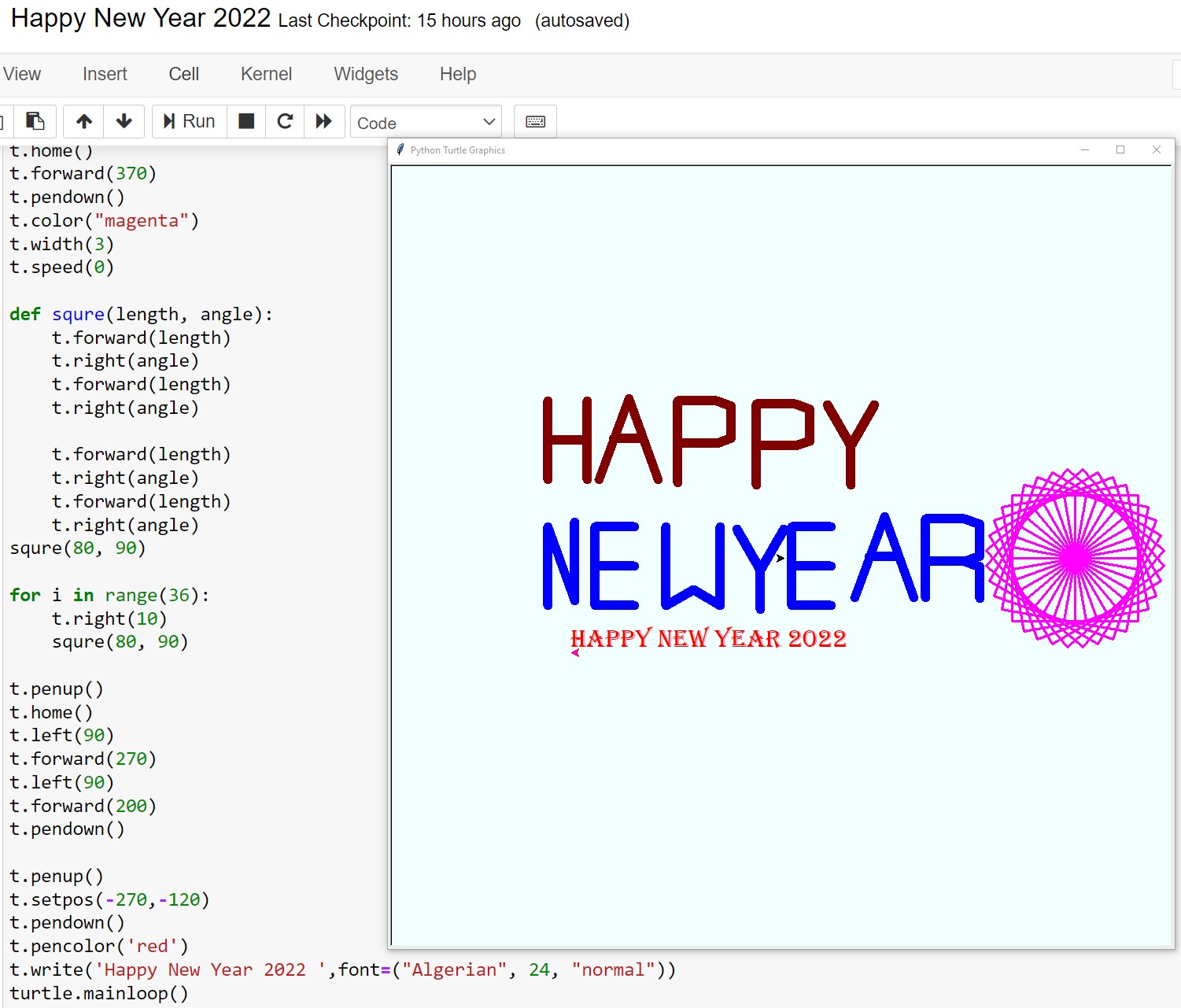
Code: import turtleturtle.setup(1000, 1000, 0, 0)t = turtle.Turtle()t.width(12)t.color("maroon")s = turtle.getscreen()t.speed(2)s.bgcolor("azure")#clcoding.comt.left(180)t.penup()t.forward(300)t.right(90)t.forward(100)t.pendown()t.forward(50)t.right(90)t.forward(50)t.left(90)t.forward(50)t.left(90)t.penup()t.forward(50)t.left(90)t.pendown()t.forward(50)t.left(90)t.forward(50)t.right(90)t.forward(50)t.penup()t.left(90)t.forward(15)t.pendown()t.left(70)t.forward(110)t.right(70)t.right(70)t.forward(110)t.left(180)t.forward(55)t.left(70)t.forward(38)t.left(70)t.penup()t.forward(55)t.left(110)t.forward(100)t.left(90)t.pendown()t.forward(100)t.right(90)t.forward(50)t.right(20)t.forward(20)t.right(70)t.forward(40)t.right(70)t.forward(20)t.right(20)t.forward(50)t.left(90)t.forward(50)t.left(90)t.penup()t.forward(100)t.left(90)t.pendown()t.forward(100)t.right(90)t.forward(50)t.right(20)t.forward(20)t.right(70)t.forward(40)t.right(70)t.forward(20)t.right(20)t.forward(50)t.left(90)t.forward(50)t.left(90)t.penup()t.forward(100)t.forward(20)t.pendown()t.left(90)t.forward(50)t.left(30)t.forward(60)t.backward(60)t.right(60)t.forward(60)t.backward(60)t.left(30)t.penup()t.home()t.color("blue")t.backward(300)t.right(90)t.forward(60)t.left(180)t.pendown()t.forward(100)t.right(160)t.forward(100)t.left(160)t.forward(100)t.penup()t.home()t.backward(240)t.right(90)t.forward(10)t.pendown()t.forward(50)t.left(90)t.forward(50)t.backward(50)t.left(90)t.forward(100)t.right(90)t.forward(50)t.backward(50)t.right(90)t.forward(50)t.left(90)t.forward(50)t.penup()t.home()t.backward(150)t.right(90)t.forward(60)t.pendown()t.backward(100)t.forward(100)t.left(120)t.forward(40)t.right(60)t.forward(40)t.left(120)t.forward(100)t.penup()t.home()t.backward(30)t.right(90)t.forward(65)t.left(90)t.pendown()t.left(90)t.forward(50)t.left(30)t.forward(60)t.backward(60)t.right(60)t.forward(60)t.backward(60)t.left(30)t.penup()t.home()t.forward(10)t.right(90)t.forward(10)t.pendown()t.forward(50)t.left(90)t.forward(50)t.backward(50)t.left(90)t.forward(100)t.right(90)t.forward(50)t.backward(50)t.right(90)t.forward(50)t.left(90)t.forward(50)t.penup()t.home()t.forward(90)t.right(90)t.forward(50)t.left(90)t.pendown()t.left(70)t.forward(110)t.right(70)t.right(70)t.forward(110)t.left(180)t.forward(55)t.left(70)t.forward(38)t.left(70)t.penup()t.forward(55)t.left(110)t.forward(100)t.penup()t.home()t.forward(180)t.right(90)t.forward(50)t.left(180)t.pendown()t.forward(100)t.right(90)t.forward(50)t.right(20)t.forward(20)t.right(70)t.forward(40)t.right(70)t.forward(20)t.right(20)t.forward(50)t.left(180)t.forward(50)t.right(20)t.forward(20)t.right(70)t.forward(40)t.left(180)t.penup()t.home()t.right(90)t.forward(215)t.right(90)t.forward(170)t.color("green")t.penup()t.home()t.home()t.forward(370)t.pendown()t.color("magenta")t.width(3)t.speed(0)def...





.jpg)



.png)




.png)





.jpg)




.png)









.png)



.png)








